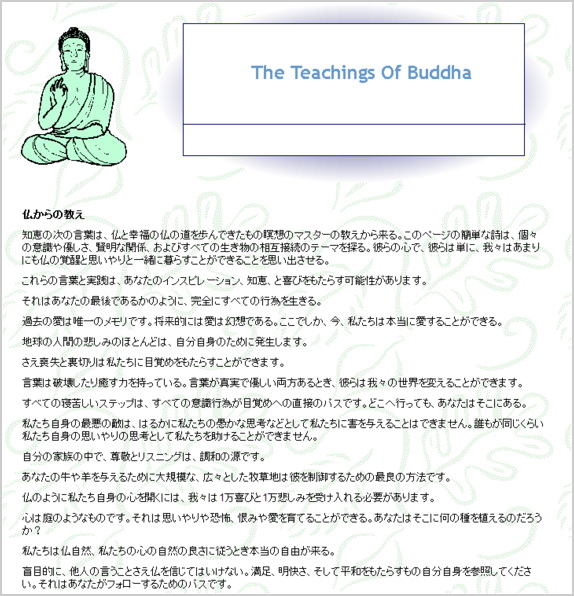BUDDHA
- One World 世界は一つ 古代イスラエルと日本の神道
- ヒンドゥー教
- 仏教の基本的なガイド
- 仏教は哲学です
- 何故カルトが蔓延するのか?
仏陀
Teachings of BUDDHA
仏からの教え / TEACHINGS FROM Buddha
知恵の次の言葉は、仏と幸福の仏の道を歩んできたもの瞑想のマスターの教えから来る。このページの簡単な詩は、個々の意識や優しさ、賢明な関係、およびすべての生き物の相互接続のテーマを探る。彼らの心で、彼らは単に、我々はあまりにも仏の覚醒と思いやりと一緒に暮らすことができることを思い出させる。
The following words of wisdom come from the teachings of the Buddha and those meditation masters who have followed the Buddha's path of happiness.The simple verses on this page explore the themes of individual awareness and kindness, wise relationships, and the interconnection of all beings.At their heart they simply remind us that we too can live with the wakefulness and compassion of a Buddha.

http://home.pacific.net.au/~thambilton/Buddha.html
仏陀の足跡に続いて / Following the Buddha's Footsteps
Instilling Goodness School City of Ten Thousand Buddhas
Talmage, CA 95481
仏教にはじめに / INTRODUCTION TO BUDDHISM
子として、シッダールタ釈迦は、子どもたちが今日は持っているのと同じ思考の一部に悩まされました。彼らは、誕生と死について疑問に思う。祖父が死んだなぜ彼らは病気になると、なぜ彼らは疑問に思う。彼らの願いが叶いません彼らはなぜだろうか。子どもたちはまた、幸福と自然の美しさについて疑問に思う。
As a child, Siddhartha the Buddha, was troubled by some of the same thoughts that children today have. They wonder about birth and death. They wonder why they get sick and why grandfather died. They wonder why their wishes do not come true. Children also wonder about happiness and the beauty in nature.
仏は子供と人類の心にあったか知っていたので、彼がどのように幸せと平和な生活を送るために皆を教えてくれました。仏教は遠い土地から奇妙な信念についての学習をされていません。それは、約を見て、私たち自身の生活を考えている。それは自分自身を理解し、どのように我々の日常の問題に対処する方法を私たちに示しています。
Because the Buddha knew what was in the hearts of children and human kind, he taught everyone how to live a happy and peaceful life. Buddhism is not learning about strange beliefs from faraway lands. It is about looking at and thinking about our own lives. It shows us how to understand ourselves and how to cope with our daily problems.
UNIT 1
BUDDHA OF LIFE
宮殿での生活 / Life in the Palace
仏教は、世界の主要な宗教の一つである。シッダールタは、ゴータマ世界に幸福をもたらすためにどのように発見したとき、それはインドで2500年前の周りに始まった。彼はカピラバストゥの小さな王国で、566年頃に生まれた。彼の父はキングSuddhodanaであり、彼の母は女王マヤだった。
Buddhism is one of the major religions in the world. It began around 2,500 years ago in India when Siddhartha Gautama discovered how to bring happiness into the world. He was born around 566 BC, in the small kingdom of Kapilavastu. His father was King Suddhodana and his mother was Queen Maya.
王子シッダールタが生まれた直後に、賢者は、彼が仏になるだろうと予測。彼は強大な支配者になるために彼の息子を望んでいたため、王はこれを聞いたとき、彼は深く、邪魔された。彼は "私たちの息子がままにしておきたいことは決してありませんように楽しい宮殿での生活をします。"、女王のマヤに言った
Soon after Prince Siddhartha was born, the wise men predicted that he would become a Buddha. When the king heard this, he was deeply disturbed, for he wanted his son to become a mighty ruler. He told Queen Maya, "I will make life in the palace so pleasant that our son will never want to leave."
16歳の時、王子シッダールタは、美しい王女、Yasodharaと結婚した。王は彼らに3宮殿、季節ごとに1つずつ構築し、贅沢でそれらをふんだんに。彼らは楽しさで、決してそれらの日に合格した
At the age of sixteen, Prince Siddhartha married a beautiful princess, Yasodhara. The king built them three palaces, one for each season, and lavished them with luxuries. They passed their days in enjoyment and never
http://online.sfsu.edu/rone/Buddhism/footsteps.htm
教え - 仏教協会 / Teachings - The Buddhist Society
'仏教は啓示宗教であることではない...
人間の経験に完全に基づいています。
仏のフォロワーは彼まで何も信じないように勧めている
それを経験し、それが本当であることが判明しました。 '
ヴェン。サダーティッサ、仏の道。 P.37 *
根本的な仏教の教え
'Buddhism not being a revealed religion …
is based wholly on Human experience.
The follower of the Buddha is exhorted to believe nothing until he
has experienced It and found it to be true.’
Ven. Saddhatissa, The Buddha’s Way. P.37*
Fundamental Buddhist Teachings
ゴータマ神、預言者や超自然的存在のいずれかの種類ではなかった。彼は我々が見てきたように、 、 、生まれたものだった住んでいた人間が死亡した。しかし、真の知恵、思いやりと苦しみからの自由を達成するための方法を発見している顕著な人間、 。むしろ、彼は常に存在していた非常に古い道を再発見。
Gautama was not a god, a prophet or any kind of supernatural being. He was, as we have seen, one who was born, lived and died a human being. But a remarkable human being, who discovered a way of achieving true wisdom, compassion and freedom from suffering. Rather he rediscovered a very old way that had always existed.
仏は神が宇宙を作成した教えていませんでした。むしろ、彼が存在しているすべてのものを介して実行して偉大な法律やダルマを指摘した。それは、真の知恵と思いやりひいては苦しみからの解放を達成することができることをこの法律に従って生活することです。苦しみしか会って我慢されることによって、しかし、克服することもできる。仏の言葉では: "私は苦しみのうち、道を教え、苦しみ。 '基本的な仏教の教義には、次のものがあります。
The Buddha did not teach that a God created the Universe. Rather he pointed to a great Law or Dharma running through everything that exists. It is by living in accordance with this Law that true Wisdom and compassion and hence freedom from suffering may be achieved. Suffering may only be overcome, however, by being met and endured. In the Buddha's words: 'Suffering I teach and the way out of suffering.' Fundamental Buddhist doctrines include the following:
ビーイングの三徴候 / The Three Signs of Being
( 1 )の変更(2)苦しみ(3 )には "私はしない"
(1) Change (2) Suffering (3) no" I "
まず、変化、世界では何も固定または永久的でないことを基本的な事実を指摘。我々自身が同じ人ではなく、物理的、感情的または精神的に、我々は10歳であったこと - 、あるいは10分前!我々がそうであるようにシフト砂によって人間をずらすように、それが私たちのために永続的なセキュリティを見つけることが可能ではありませんが、その後、生きている。
The first, Change, points out the basic fact that nothing in the world is fixed or permanent. We ourselves are not the same people, either physically, emotionally or mentally, that we were 10 years - or even 10 minutes ago! Living as we do, then, as shifting beings upon shifting sands, it is not possible for us to find lasting security.
第二のサインに関しては、我々はすでに苦しみは元の単語、苦の非常に良い訳ではないですが、それは、彼の偉大な精神的な探求に仏を退場することに苦しんでいた方法を見てきました。苦は人生の一般不満足と不完全な性質を意味する。
As regards the second Sign, we have already seen how it was Suffering that sent the Buddha off on his great spiritual quest, though suffering is not a very good translation of the original word, dukkha. Dukkha implies the generally unsatisfactory and imperfect nature of life.
してくださいは、仏教徒は、その人生はすべての苦しみであると信じている、しかし、とは思わない。彼らは、人生の喜びがあると信じているが、その人生はすべての喜びすることはできません知っている、でも、生活の中で最も幸運でそこに苦しみしなければなりません。
Please do not think, though, that Buddhists believe that life is all suffering. They believe that there is joy in life, but know that life can't be all joy; even in the most fortunate of lives there must be suffering.
ノー-I 、三印は、少し難しくなります。
仏教徒が人間に永遠不変または何かがあると信じていない、ない魂や自己いる'I'の安定感は、それ自体を固定しないかもしれません。 'I'の全体的なアイデアは、実際には要素の不安定で一時的なコレクションに自分自身を設定しようとすると基本的に偽の一つです。
No-I, the third Sign, is a little more difficult.
Buddhists do not believe that there is anything everlasting or unchangeable in human beings, no soul or self in which a stable sense of 'I' might anchor itself. The whole idea of 'I' is in fact a basically false one that tries to set itself up in an unstable and temporary collection of elements.
カートのアナロジーを取る。カートはその後、カートはもうありません、その基本的なコンポーネント·車軸、車輪、シャフト、側面などに分解することができ、我々が持っているすべてのコンポーネントの山である。同様に'私は'様々な要素または集計( skandhas )で構成されています:フォーム(ボディ) 、知覚、概念、意志、意識(心を) 。
Take the analogy of a cart. A cart may be broken down into its basic components -axle, wheels, shafts, sides, etc. Then the cart is no more; all we have is a pile of components. In the same way 'I' am made up of various elements or aggregates (skandhas): form (body), perception, conception, volition and consciousness (mind).
これらの要素は、宇宙の顔から消えていない死の時に、彼らは他の場所で新たな組み合わせを形成する。したがって、宇宙全体は、先頭または末尾なしで相互接続された運動の偉大な、刻々と変化するオーケストレーションです。
Upon death these elements do not vanish from the face of the universe, they form new combinations elsewhere. Thus the whole universe is a great, ever-changing orchestration of interconnected movements without beginning or end.
http://www.thebuddhistsociety.org/resources/Teachings.html